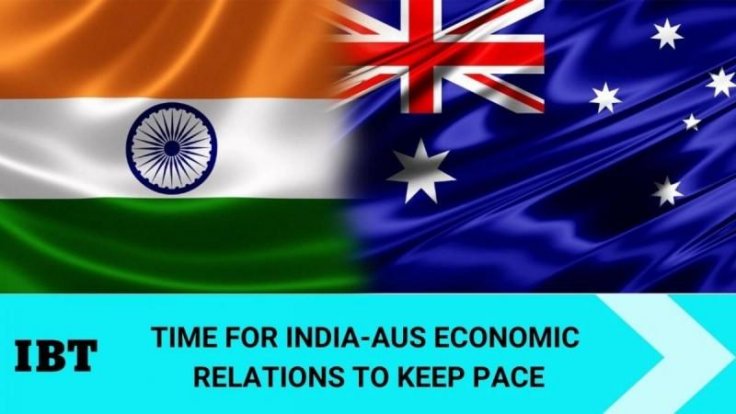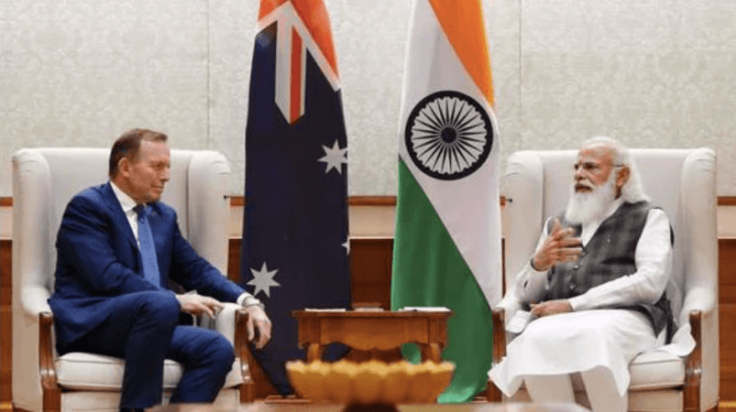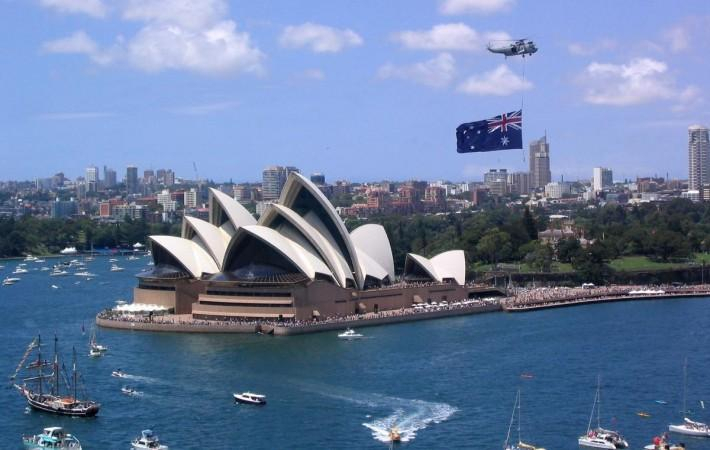The recent visit of former Australian Prime Minister Tony Abbott to India was an important event that received limited attention in the media. The visit which Australia officially called, "..an opportunity to progress Australia's ambitious agenda to energize and expand our bilateral trade and investment relationship with India" saw Mr. Abbott calling on Indian Prime Minister Narendra Modi, important officials, and business leaders in a bid to accelerate the negotiation of a free trade agreement with India.
Missed opportunities, shared goals
The Australia-India relationship has often been called one of the missed opportunities —of tremendous potential but largely unrealized. Despite obvious symmetries including language, democracy, a colonial legacy, and a large diaspora; it has often been dismissed as a relationship confined to cricket, curry, and commonwealth.
While Australia and India were not on the same side during the Cold War, in more recent times, hitching its economic star to the fastest growing economy in the world made more sense to Australia. Of course, there was 1998 when the Australian Government had decided to swiftly and severely downgrade relations with India following India's nuclear tests.

The Red unifying factor
The two countries have since traveled quite a distance and the partnership has seen a steady upward trend in recent years, driven by a converging regional strategic vision as well as shared concerns about China. The two-way Prime Ministerial visits in 2014 have further lent significant momentum to the relationship.
The recent 2020 'virtual' summit between Indian Prime Minister Narendra Modi and Australian Prime Minister Scott Morrison saw the relation being further upgraded to a "Comprehensive Strategic Partnership." Australia's recent experiences with China have led to a better understanding of India's position and our demonstrated ability to stand up to China whether militarily or strategically finds much more resonance now.
Australia is increasingly becoming a strategic partner, it is time for economic relations to keep pace
Are India and Australia close enough?
While strategic and defense cooperation has seen a significant advance, the trade and investment relations and people-to-people exchanges between the two countries still do not reflect the potential that actually exists between them. It is ironic that despite a strong cricketing relation and a sizeable diaspora, there does not appear to be a broad civil society engagement or a great people-to-people contact.
Even tourism exchanges have been unflattering - only 3.28% of international tourists to India were from Australia (2019); the corresponding figure for Australia was 4.2%. The figures for China were 15.14%. Even tiny Singapore contributed 5.03%. It is telling that direct India Australia flights began less than a decade ago.
The case for a Free Trade Agreement
On trade and commerce, the suboptimality is stark —India's exports to Australia were $ 3.5 billion in 2018-19, a little over 1% of India's total exports and spread out over a host of items with little to distinguish. (The USA is India's prime export destination and accounts for 15% of India's exports). Australia's exports to India were approximately $ 13 billion- concentrated around mineral fuels-largely coal ($ 9.6 billion) and constituted 3.9% of Australia's exports (China accounts for over a third of Australia's exports). Australia accounts for 2.5% of India's imports.
Australia's exports to India are reflective of her natural endowments. Her major export to India is her second-largest export item and also a major import item for India although she also exports animal fats which India does import but not much from Australia. But India's exports to Australia are not Australia's major import items although India does have a presence on the global market for apparel, vehicles, and pharmaceuticals, which are significant in Australia's import basket.
It is in this backdrop that the 2020 summit level commitment to 're-engage on a bilateral Comprehensive Economic Cooperation Agreement (CECA)' as well as the recent call to enhance people-to-people contacts could not have been more timely. A free trade agreement with Australia could be a sensible move for both countries. It would not only cement and complement a promising strategic partnership but also be a harbinger of a 'shared prosperity".
Indian automakers and to a lesser extent toy and apparel makers will be able to access the Australian market. For Australia's firms, the gains from an FTA would be secured access. This is because Australia already has a considerable presence in India's coal market. India's natural gas market is currently dominated by the Gulf countries and though unlikely to change in the short term, yet offers promise for Australia. Purchase of Australian gold by India given relative inelastic supplies would merely be a trade diversion.

Australia has an obvious advantage and interest in pushing agri-exports although India's ability to make significant concessions on agriculture access would be constrained by domestic compulsions as well as cultural sensitivities e.g. with respect to beef. Yet, there do remain markets in wine, dairy products, and other high-end niche markets of interest to Australia where fruitful negotiations are possible. On the Australian side, concessions on a more relaxed visa regime and freer people movements will remain problematic although here too, meaningful discussions are possible, particularly on professional and technical movements.
There are obvious constraints caused by differences in perception besides the natural limitations imposed by the size and composition of the Australian market but past experience of economic exchanges between the two countries may not be the best guide to what the future may hold. Australia needs to reduce its overwhelming dependency on China as an export destination and moderate its reliance on primary goods exports.
Australia accounts for 2.5% of India's imports.
India not only needs to export more but also (and more importantly) needs new technologies to improve productivity. This is where Australian expertise in mining, technology, gaming, and agri-business can help. In agriculture too, Australian technology and investment can play a role. While the use of technology and scale of operations are obvious examples, equally important are innovations in transforming agricultural practices to work in rainfall deficient or water scarcity lands leading to movements like permaculture.
Given the increasing number of Indian States that are water-stressed, the looming threat of Climate Change, and the importance of agriculture in India for employment and income, any innovations in agricultural practices would be of immense use.
More areas of negotiations to explore

Indian investment in Australia in infrastructure already exists. Most Indian IT majors are also represented in Australia. But other technology firms from India could explore avenues in Australia-Indian filmmakers and IT firms that cater to the entertainment industry and special effects may well take advantage of Australian expertise. In the same vein, Australian leadership in pension funds could open up huge investment avenues.
Australia's dynamic and innovative fintech could seek complementarities in the raw energy of India's start-ups and see how ideas could be monetized for the benefit of all stakeholders. On Climate Change which is of great interest to Australia and significant concern to India, the complementarities are again evident. With the latest IPCC report sounding the code red for the world, countries like India are disproportionately vulnerable. Any suggestions for collaboration on the Climate Agenda will find an enthusiastic resonance with Australia.
Then there is culture
The over half a million strong diaspora represents a natural starting point for social and people-to-people exchanges. This can easily be complemented by enhanced academic, cultural, and sports interactions besides greater tourism. Blossoming economic, sports, and cultural ties will not only lead to greater appreciation and mutual respect but also play the same role as Indo-US bodies and Indo-French bodies have played in influencing policy and catalyzing and converging the economic and strategic interests of the two countries.
Both countries have already made a beginning by commissioning respective country strategies. Australia's An Economic Strategy for India to 2035 envisages Australian exports rising by five times and investment by ten times in 20 years, making India among Australia's top trade and investment partners. India's reciprocal report, perhaps the first and the only one for any country, Australia Economic Strategy (AES) identifies 12 sectors for enhanced collaboration.
A freer India-Australia economic and cultural engagement that involves trade, investment, services, and people will create long-term opportunities for entrepreneurs and investors in both countries to venture into mutually beneficent relationships without being encumbered by the shadows of the past. This will be a relationship based on investment, technology. know-how, ideas, and people. This will be a relation to complement and strengthen the warm and accelerating strategic and security partnership. But most of all, it will be a relation of symbiosis and serendipity, the discovery of an unchartered yet promising land.
It is this possibility of discovery that must be given space by policymakers in both countries.
- Rohit Kansal is a senior IAS officer. He has been an Emerging Leaders Fellow of the Australia India Institute at the University of Melbourne
- Dipankar Sengupta is a Professor of Economics at the University of Jammu
Disclaimer: The views expressed by the authors are personal








